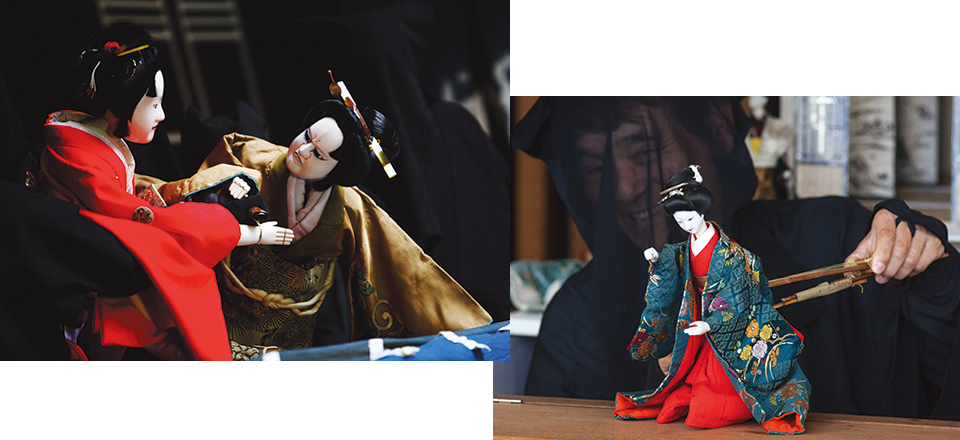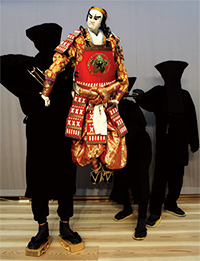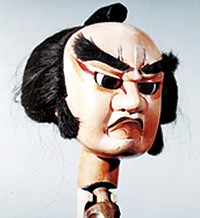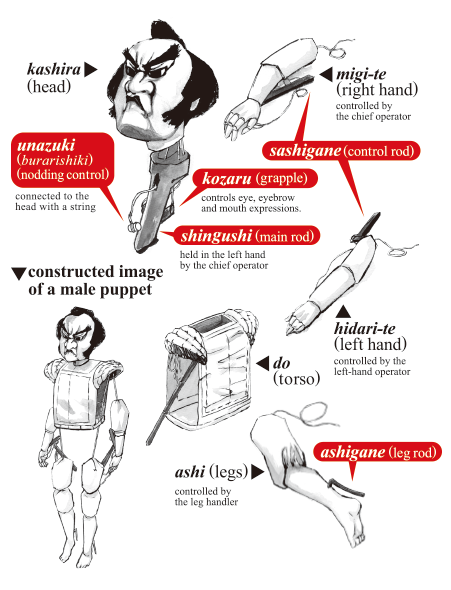Joruri is a Japanese traditional performing art where the narrator (tayu) tells a story accompanied by a three-stringed instrument (shamisen).
It was named Joruri after a princess in the mid-15th century classic love story of Ushiwakamaru and Jorurihime.
Ningyo Joruri is the art of manipulating puppets (ningyo) to a sung narrative (joruri) and is a composite art form expressed by the trinity (sangyo) of
narration, shamisen and puppeteering, in total synchronization.

In order to support the narrator's free-form expression, the shamisen player pays strict attention to the narrator's breathing and use of negative space (ma). Puppeteers manipulate the puppet in unison with the narration, yet at the same time are constantly aware of eye direction and the sense of distance between the dolls. Careful, meticulous operation and simple expression underlined with delicate sensibility is vital to this art. Within this, is the Japanese sensibility, condensed.
Puppet theater is considered to have been established in the late 16th to early 17th century when three artistries (sangyo) united in a trinity. Developing with Nishinomiya puppetry as its roots and centered around Kyoto and Osaka, Awaji puppet troupes and Awadeko Hakomawashi troupes of Tokushima toured throughout Japan, conveying puppet theater's charm. Puppets come in various forms; manipulated by either three puppeteers, a solo puppeteer, with strings or by a puppeteer on a mobile chair. Each region transmits puppetry culture in diverse ways. Some pursue higher artistic quality or are enjoyed as a local entertainment, while others are dedicated as Shinto rituals.
The narrator recites the narrative using an onstage libretto, yet there is no score as in western music. Emphasis is not only on rhythm and melody but also on "telling of the tale" with a full range of emotion. This solo artistry encompasses scene description and providing story background as well as speaking the lines and describing gestures by getting into the soul of characters young or old, man or woman, good or bad, in different tones.
The shamisen type used for puppet theater is known as gidayu shamisen, characterized by its broad neck and rich, sonorous tone. It is capable for amazingly rich and diverse expression. As the thick, heavy plectrum scratches, plucks or pelts the silk strings, it creates sounds massive and penetrating or feeble and weepy. It stirs a sensation of anxiety, even conjuring a feeling of being hot or cold.
 When three puppeteers manipulate a puppet, the chief operator (omo-zukai) works the head and the right hand, while the left-hand operator (hidari-zukai) moves the left hand and the leg handler,(ashi-zukai) moves the legs.
The core elements of puppeteering are subtle movements from eye direction to the fingertips as well as basic movements such as walking, standing and sitting as if solid ground is beneath the puppets' feet. A world of wonder unfolds before one's eyes as the puppets come to life, sometimes appearing more human than one made of flesh and blood.
When three puppeteers manipulate a puppet, the chief operator (omo-zukai) works the head and the right hand, while the left-hand operator (hidari-zukai) moves the left hand and the leg handler,(ashi-zukai) moves the legs.
The core elements of puppeteering are subtle movements from eye direction to the fingertips as well as basic movements such as walking, standing and sitting as if solid ground is beneath the puppets' feet. A world of wonder unfolds before one's eyes as the puppets come to life, sometimes appearing more human than one made of flesh and blood.
 Although differences remain according to region and troupe, generally heads with sharp eye corners (kadome) play the starring role or good characters, while heads with round eye corners (marume) play the enemy or bad characters. Doll heads with thin eyebrows drawn in black and unstained white teeth represent unmarried maidens (musume), while middle-aged married women doll heads (nyobo) have shaved eyebrows drawn in powder blue and blackened teeth. White hair and deep facial lines represent old ladies (baba). Understanding these basics helps one imagine the role and true nature of the characters onstage, deepening the puppet theater experience.
Although differences remain according to region and troupe, generally heads with sharp eye corners (kadome) play the starring role or good characters, while heads with round eye corners (marume) play the enemy or bad characters. Doll heads with thin eyebrows drawn in black and unstained white teeth represent unmarried maidens (musume), while middle-aged married women doll heads (nyobo) have shaved eyebrows drawn in powder blue and blackened teeth. White hair and deep facial lines represent old ladies (baba). Understanding these basics helps one imagine the role and true nature of the characters onstage, deepening the puppet theater experience.
